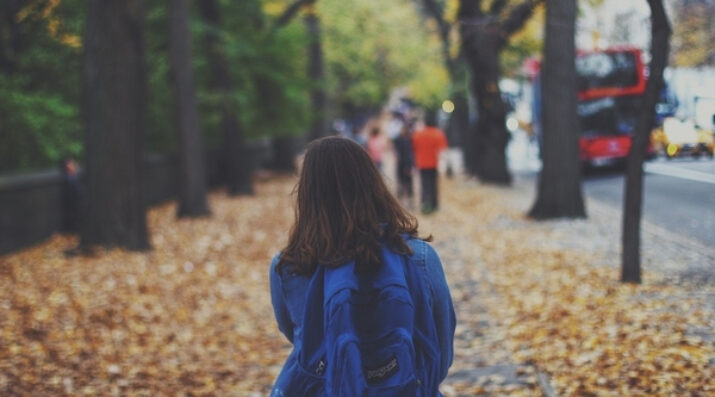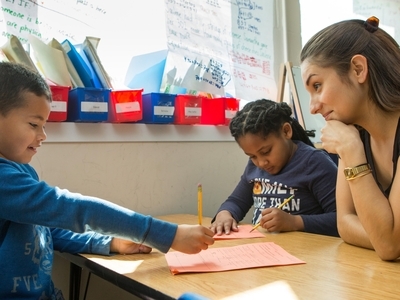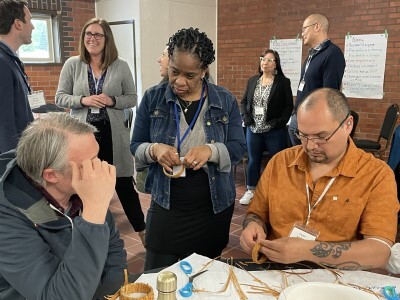The Multiple Fallacies of Reopening School
Topics

Next generation learning is all about everyone in the system—from students through teachers to policymakers—taking charge of their own learning, development, and work. That doesn’t happen by forcing change through mandates and compliance. It happens by creating the environment and the equity of opportunity for everyone in the system to do their best possible work.
A failure of imagination may be the greatest barrier to opening schools in ways that provide the best learning conditions for students during the pandemic.
There’s a huge elephant in the rooms where conversations about school reopening are happening. In fact, there are several. The conversations go like this: “How many students can we fit into classrooms if they sit in rows of desks that are separated by six feet, and wear masks, and don’t get up and move around? How many days a week does that mean students can be ‘in school’ vs. ‘at home?’” First I am going to talk about these elephants, and then I am going to explore how we might frame our reopening conversations differently.
Elephant #1. Bad pedagogy. An education that trains students to sit passively six feet apart and not interact, while passively receiving information from a teacher standing in the front of the room, and filling out worksheets spewing back that information, is an outmoded pedagogical approach that is not going to prepare them to be the citizens of the immediate or longer term future. That is, this is not how young people learn. Such a pedagogical approach will not prepare our young people to face the current challenge of the COVID pandemic, or to lead in addressing the next complex challenge to come along, whether that is the murder of George Floyd and the broadening of the BLM movement, a stark reminder that we live in a nation still guided by white supremacy, or the failure of leadership at the federal level. And yet, it is still the predominant image that many parents, community leaders, and policymakers seem to be carrying with them, albeit unconsciously, as they think about school reopening this fall. It is “the way school is supposed to be,” left over from what is familiar and reassuring from their own—not very positive—experiences in school.
Elephant #2: Inequitable resources for families. School district people, community leaders, and policy makers cannot seem to admit the inequities in assuming that parents can supervise the learning that their children will do when they are not in classrooms. The inequities inherent in this assumption are profound; in fact, as I write there is a movement that has arisen almost overnight: small groups of parents of means (and that translates to mostly white and affluent) are hiring teachers, many away from their public school jobs, to teach their “pods” of kids at home. We are facing a dramatic change in how education is structured, and it won’t benefit those students most in need unless school districts get ahead of this dangerous curve.
Elephant #3: Band-aid supports for children. We have transferred the responsibilities of a civil society onto schools in a multitude of ways.These are becoming starkly apparent as we attempt to imagine how schools can provide the services that our society has abdicated responsibility for. Alison Hoeman, a teacher from Des Moines, Iowa, succinctly describes some of those as (I am summarizing her words here):
For decades, schools and teachers have been the band-aid on society’s failings because we care about children. Schools and teachers are not the ones that can fix the things that are broken with our society. At the same time, we cannot be the lambs sent to slaughter because no one else cared enough to actually fix society while schools and teachers were holding it all together with said band-aid.
Society: In the richest country in the world, between 11 and 13 million children live in food insecure homes… Over 4 million children in the U.S. do not have health insurance or adequate healthcare… Over 17% of U.S. children live without basic necessities… There are 5.5 million reports annually of physical abuse, sexual abuse, and neglect… Almost 25 percent of U.S. children have parents that work past school hours… Almost 14 million children in the U.S. are obese… The U.S. averages one school shooting every 77 days.
School: We can help; we can help; we can help...
Society: We are in the midst of a global pandemic which our government has failed to control. Almost 130,000 Americans are dead and the numbers are rising, not declining, in many places. Because we have chosen to ignore, for decades, the racism, inequality, and discrimination that is at the root of all the aforementioned problems, we now need schools to reopen so that kids can eat, get healthcare, get clothes, shoes, and school supplies, be safe, be healthy, and be supervised. Oh, and so that they can get an education.
Teachers: We can help....
A Failure of Imagination with Disastrous Consequences
These images, of passive learning, of parents as study hall monitors, at best, or in “pods” of affluent families turning their backs on public school entirely, of schools as being able to meet all the needs that society has refused to, are fundamentally the wrong images to hold in our public (un)consciousness right now as we plan for reopening school. They contain multiple fallacies about the purpose and processes of school and public education. These fallacies are lying unexamined, the elephants in the room, in the current conversation about reopening school.
These are images of the ways in which school has served to manage children so parents can work, and control students’ bodies to enforce overly narrow norms of “learning,” and meet needs that society is not meeting. Attempts to control students when they are no longer sitting in traditional classrooms, and enforce highly prescribed regimens of learning outside of school classrooms, are almost impossible. And even if these kinds of control were possible, it does not mean that they will create the conditions for students to engage in any kind of meaningful learning.
Sure, if we expect teachers to become even more enforcers of social control than traditionally has been the case—enforcers of sitting still and not getting up, enforcers of wearing masks, enforcers of social distancing, enforcers of a vision of learning as filling out worksheets quietly at your desk—and if we expect parents to be “study hall monitors” at home, monitoring their childrens’ completion of packets of handouts or showing up for Zoom “classes,” or even those who can afford to just completely giving up on public school—we might succeed. But at what?
This is a chance to challenge everything we have come to believe about “the way school is supposed to be.” Let’s use this opportunity. Let’s get started.
This educational system will not prepare all young people to become the agents of change who can skillfully take on the challenges of this still-new century. An education that trains students to sit passively and not interact is not going to prepare them to face the current challenges of COVID and the other pandemic, the realization that we live in a nation still fundamentally guided by racist and white supremacist culture and systems. It also won’t prepare them to lead in addressing the next complex challenge to come along. In a recent blog post, Adelric McCain put the equity and learning challenge this way:
In particular, we can use this time to pause and rethink some of the most inequitable and institutionalized assumptions that underlie our current education system: that expertise in the classroom lies entirely with teachers; that a precondition to learning is that adults control students’ bodies, particularly Black and Brown bodies; that the quantity of content and standard coverage, rather than the depth of students’ understanding, should drive the work of a classroom; and that students who don’t do the work, don’t care about school. Indeed, these times of protest, sacrifice, and strife have laid bare the fundamental misalignment between what schools ask of students and what students actually need. At the same time, innovative strategies and perspectives on teaching and learning emerged this spring, forcing us to expand our thinking about what is possible and make difficult decisions about what our students need us to leave in the past and hold onto in the future.
The current conversation about school reopening, and the worn old images it conjures, demonstrate a complete abdication of adult and community responsibility for the education of each and every one of our young people to become whole, healthy, functioning, and thriving adults who can actively participate in our society. And they represent a failure of imagination, a failure to imagine that school could happen in any other way than “the way school is supposed to be.”
A New Conversation: Creating Conditions for Essential Learning
So, what might some different conversations be, who might participate in them, and what might some different images of our educational system in the age of pandemics look like?
Here is a series of questions we might start with: What kinds of learning outcomes do we aspire to for each and every one of our young people, irrespective of whether we are in the midst of a pandemic? What kinds of learning experiences might help our young people achieve those outcomes? What are the conditions that would support them to have those experiences and be successful at their learning? How can we engage people across our communities in thinking through what we want to do as we explore these questions and test out some tentative answers?
Learning Outcomes: The Hewlett Foundation, among others, states these as essential learning outcomes for 21st-century learners: Students need to master core academic content, think critically and solve complex problems, work collaboratively, communicate effectively, learn how to learn, and develop academic mindsets.
Learning Experiences: Jal Mehta and Sarah Fine describe the kinds of learning experiences that can lead to these outcomes in their book, In Search of Deeper Learning, and we captured those in the Deeper Learning Dozen white paper this way: “In aspiring to give all students access to deeper learning, we are aiming for all students to have experiences that develop their mastery, identity, and creativity.” Fullan, Quinn, and McEachen add connectedness to the dynamics of deeper learning: “What gives humans meaning in life is: a strong sense of identity around a purpose or passion; creativity and mastery in relation to a valued pursuit; and connectedness with the world and others.” Ron Berger of EL Education and Jessica Forbes, an English teacher in the Public Health Academy at Oakland High School (disclosure: Jessica is my wife), describe deeper instruction as involving work that matters (that is, meaningful to the students); the opportunity to engage in productive struggle with texts (of various kinds); opportunities for voice, choice, and agency; iterations of practice and revision of work towards high standards of quality, with feedback from teachers and peers; thus, learning that is active and sustained over time; creating knowledge rather than just receiving information; and authentic audiences, and purposes, for the products students create that demonstrate their learning.
Learning Conditions: What are the conditions that would support these kinds of learning experiences? We know that learning is a dynamic and social process, so young people need to be able to interact with one another and with others, of many different ages, to become successful learners. We know that persistent trauma and stress narrow the capacity of the developing brain to be flexible and learn, but that the brain is naturally malleable and flexible when stress and trauma can be managed, and intelligence and ability are not at all fixed factors in young people and adults, if the conditions support that (Turnaround for Children). We know that learners need safe and trusting relationships, and supportive structures to frame the conditions for learning. We are talking about creating a learning space for curiosity, rigor, and joy. And good teachers, schools, and communities have been creating these conditions and providing these pedagogical containers for learning for a long time. This is not radically new practice.
If we started there, why would we even think that social distancing of students sitting in rows of desks six feet apart would work? If we started there, why would we expect that time “outside of school” (as in, outside the school building) would be managed by nuclear families alone, or that school districts might abdicate their role and let pods of affluent families create their own “outside of school” classrooms? If we started there, why would we expect schools to figure out and manage all of this by themselves, without community, business, social service, and public agency involvement? Why would we be asking whether it is better to have in-school time focus on electives and all core academic courses would be online? In truth, why would we even be talking about “courses,” a system derived from the scholasticism of the middle ages to mirror Aristotelian categories from ancient Greece that have less and less to do with our daily lives. This is a chance to challenge everything we have come to believe about “the way school is supposed to be.” Let’s use this opportunity. Let’s get started.
Learning Designed for, not despite, Pandemics
Where should we start? First things first: Have we spent any time engaging with the young people who are the first generation to be “out of school” because of a pandemic across the nation (many schools closed temporarily during the 1918 flu epidemic, but there was not wholesale closing for months across the nation), to ask them what their experience has been like? What have they learned about their learning? What can we learn by asking them about their experiences, needs, and imaginings about what school could be (not what school has been)? Have we engaged families in similar conversations about what they want for their young people? Have we sat with community partners, or taken full advantage of the collaborations already in place with the community schools model, and asked what kinds of learning they support, and how they might be more proactive and collaborative partners in rethinking learning spaces, places, and times? What role should our business community be playing, since the strength of the local economy is going to be dependent on the education of its citizens? What role should town and city governments play? Social service agencies? Meg Wheatley puts it this way, “To create better health in a living system, connect it to more of itself. When a system is failing, or performing poorly, the solution will be discovered within the system if more and better connections are created. A failing system needs to start talking to itself, especially to those it didn't know were even part of itself.” How have we brought the people together to think creatively about this new era, about what school could be?
Where might this conversation lead us? Here’s one example: In Kettle Moraine School District in Wisconsin, even before these pandemics, teachers and students have been thinking differently about how to come together to learn. One example is their Math Pathways, an approach to math that does not assume all kids need to progress sequentially through a discrete course in a classroom with thirty students studying algebra, then another on geometry, then algebra II, etc. Content is all online and individually paced, as in a “flipped classroom.” But when students come to school, they gather in a very large group in a large open space with tables and chairs, and all their math teachers and special education teachers and several other support personnel are in the room too. Students self-organize into smaller groups working on similar content, and help each other learn. When they need the help of an adult, they can call one of the teachers over to provide that help. Now, that kind of large gathering is not going to happen in the early days of reopening school, if at all this year. But what if the individual content learning happened the same asynchronous and self-paced way, and then students could gather regularly in a virtual synchronous “marketplace,” or “commons,” and then self-sort into smaller break-out virtual spaces to work in the same way as they did in the actual space before? They could signal (as people in Zoom breakout rooms can) that they need a teacher to join them to help out when needed, and otherwise work together on their small group focus until they feel ready to go on to something else.
Creative and imaginative teachers and students have been coming up with great learning designs for a long time, and many of these could translate into virtual and physical settings outside school buildings.
What if teachers in a smaller academy or house could co-plan larger, longer term projects that integrated content and had a larger focus on an issue of social or political concern to the students? Teachers could provide tag-team virtual support to teams of students working on aspects of that concern, with community-based organizations providing spaces and additional learning time and support for the learning? An example from my wife’s teaching is a project they’ve been doing in her school’s Public Health Academy about the American Dream (and who gets to participate in that dream, and whose dream is it anyway; are their psychological implications or pathologies for us as we attempt to achieve it?). Students read Death of a Salesman, learn about and examine the social determinants of health, and engage in a community mapping project to gather data connecting individual and community health issues with poverty and racism in their own communities. It ends with social action projects that students choose based on their interests. (One year, for example, they gathered evidence and wrote arguments about the problems of illegal dumping in their neighborhoods. They crafted solutions to the problem, which they presented to the mayor and the public works department at a community action organization’s meeting).
What if teachers and the business community helped young people connect with adults in internships and apprenticeships, such as the son of the man who came to paint our house two weeks ago? Jonathan was his father’s interpreter, because my Spanish is terrible. He learned to communicate back and forth with us about what we wanted, the work they would do, the cost negotiations, the paint we would need to purchase in advance, the amount of time the project would take, how we would pay, etc. And then he helped with the preparations of the house, the organization of the materials, the actual painting, the communications with us during the process, and the cleanup and completion of the job at the end, as well as checking in with us to make sure we were satisfied with the job they did. Go back and check the list of essential learning outcomes and deeper learning experiences I described above against Jonathan’s experience. Clearly not all powerful learning happens “in school” nor in traditional content course areas.
What if organizations that take young people into the wilderness (such as Outward Bound) partnered with schools to create “pods” of students and teachers collectively in social isolation, with wilderness instructors, and spent a month in the wilds living together and learning? The possibilities for learning include wilderness experiences and skills, group communication and collaboration skills, complex problem solving skills, and meaningful content about, say ecosystems, or the history or the literature of specific places. These sorts of experiences could take some pressure off school systems providing hybrid school options while offering truly powerful learning for young people and adults alike.
And how might we address this emerging phenomenon of affluent parents hiring teachers away from the public schools to teach their pods of students? Districts could get ahead of the curve here by actually funding such pods, but in a way that requires its standards of diversity, equity, and inclusion to be addressed.
Whether or not students enter school buildings to learn, they have ample opportunity to engage in meaningful work, to work collaboratively, to read and grapple with text, to write and get feedback and revise their own texts, to work with community-based organizations to determine specific community needs, design civic engagement projects to address those needs, and publicly present work that demonstrates their learning to authentic audiences. This kind of learning requires teacher support, to be sure, but it does not place the teacher in the role of the sole enforcer of meaningless, rote tasks in highly controlled environments.
Creative and imaginative teachers and students have been coming up with great learning designs for a long time, and many of these could translate into virtual and physical settings outside school buildings. To be sure, this is hard work. I don’t want to downplay how hard teachers worked this past spring to figure out how to engage their students in powerful and meaningful learning when they could not meet with their students face-to-face in their classrooms. But if we don’t ask students and teachers and families, if we don’t look for great examples, if we stay stuck in old paradigms of the organization of school, if we think we can sit in a district office and come up with the perfect reopening plan without getting out there and seeing what exciting ideas students and teachers have, if we don’t demand that the community get more involved in supporting us, then school this fall will fail miserably.
Let’s not fail our students or their future. Stop looking back at the way school is supposed to be. Stop pretending we can create settings where students will dutifully and passively follow public health guidelines even if we know those can’t work and don’t support good pedagogy. Start asking what school could be. Now is the time.
Photo at top by "Free-Photos"




